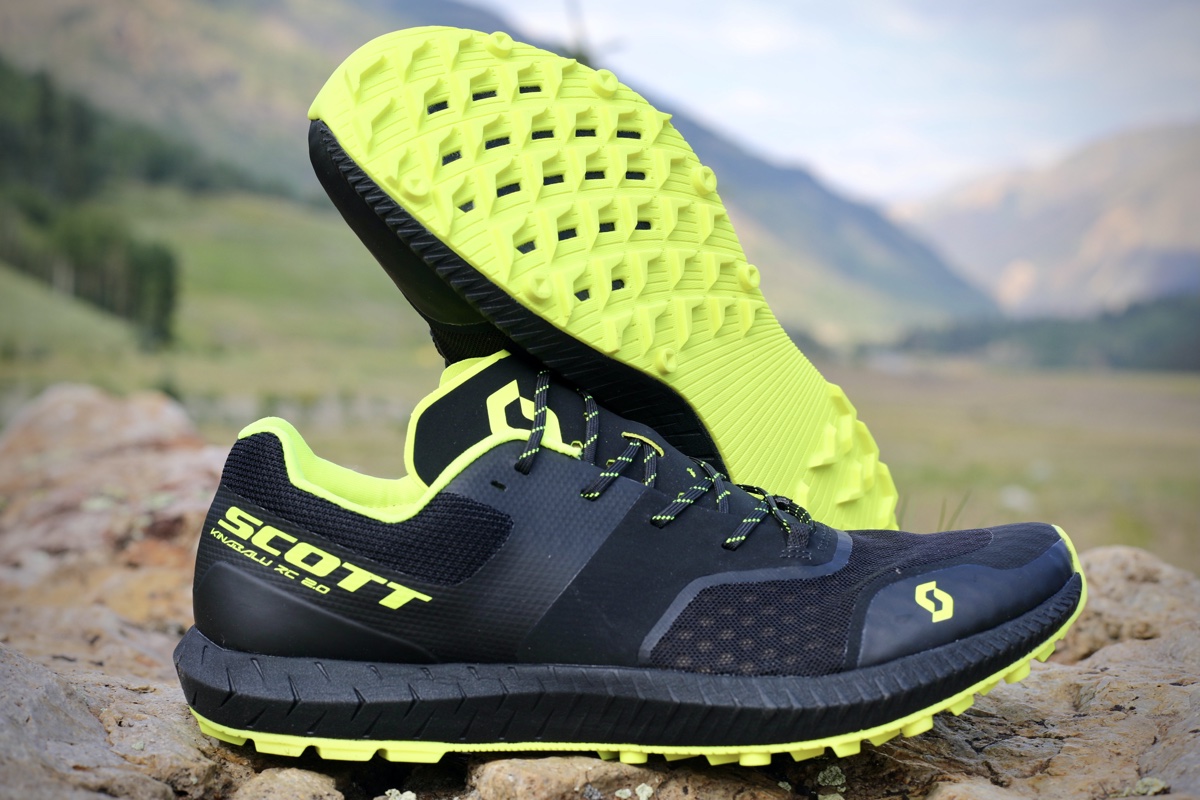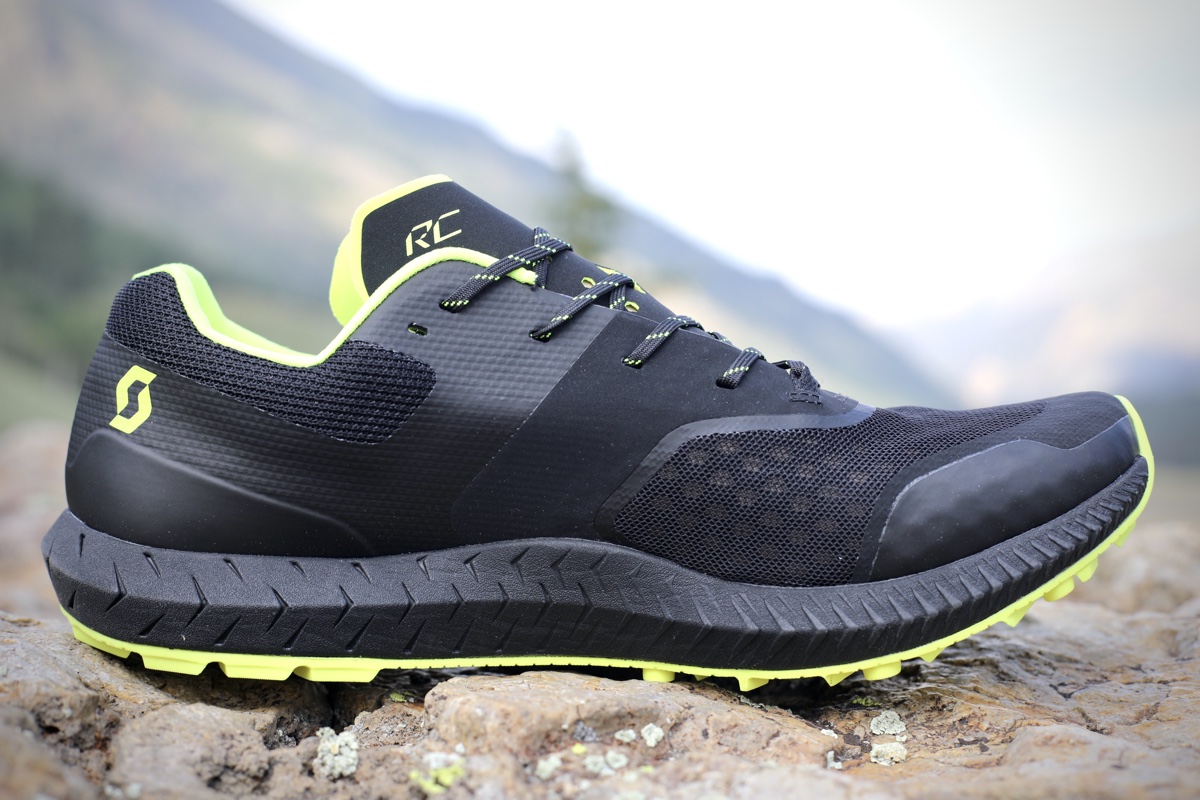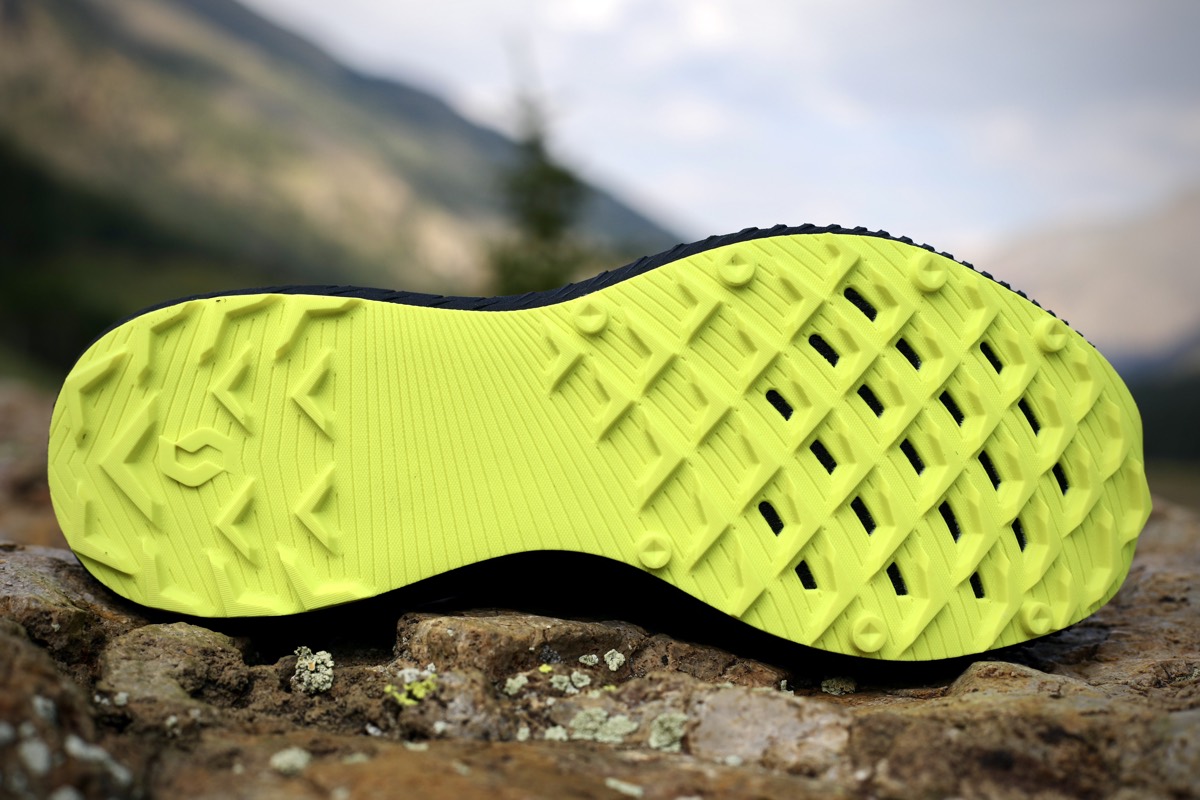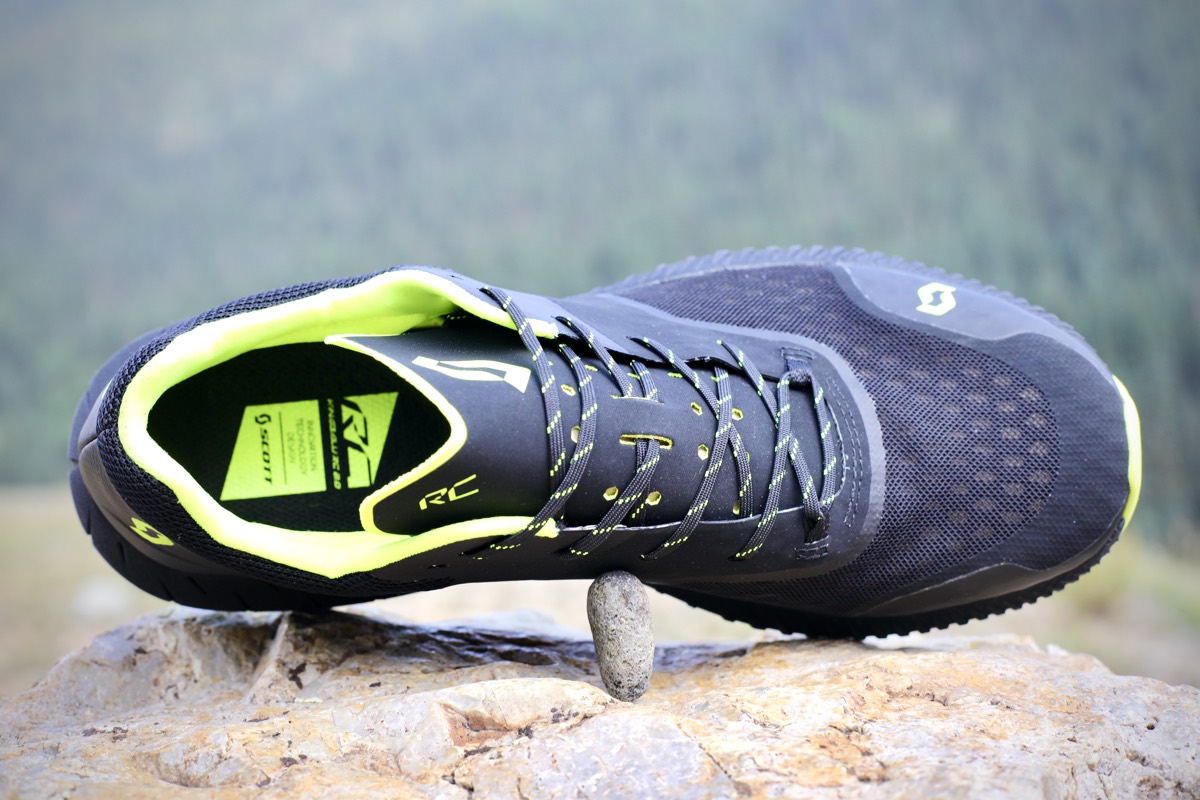The Scott Kinabalu RC 2.0 ($160) is a super-lightweight shoe that offers exceptional comfort, good cushioning, and great grip. Though it’s racing-oriented, it’s fun to run in anytime.
I’ve already tested another quite similar shoe, the Salomon S/Lab Pulsar — read our Salomon S/Lab Pulsar review — so if you’ve tried the Pulsar, you’ll probably also like the Kinabalu RC 2.0.
We rated the Kinabalu RC 2.0 as one of the best lightweight shoes for racing in our Best Trail Racing Shoes guide. It is very light at an actual weight of 8.8 ounces (249 grams) in a men’s size 9, and it has a 3-millimeter drop.
Do be warned: you will want to limit your racing distance to sub-marathon or at most 50 kilometers; this is from my personal experience and Scott’s own recommendation. The brand calls this a trail marathon shoe and not just that, but a groomed trail marathon shoe. This too is accurate; while the grip is good, the lug pattern is called Hybrid Traction, which is supposed to deliver straight-line power transfer on smooth trails.
Reader comments on another of our recent Scott shoe reviews — our Scott Kinabalu Ultra RC review — indicated that availability in the U.S. is tough to come by and with this shoe comes a lot of specificity. But if it speaks to your style of racing and day-to-day training, then read on to see if it’s worth tracking down.
Shop the Men's Scott Kinabalu RC 2.0Shop the Women's Scott Kinabalu RC 2.0
Scott Kinabalu RC 2.0 Upper
Scott remarks in its product description about how breathable the Scott Kinabalu RC 2.0’s upper is, but I think its durability should also be touted. Sure, there is a large section of the toebox that is mesh, and it wraps around the side to the first third of the shoe. But in sharp contrast are the fairly thick and stiff TPU overlays that have done an exceptional job in preventing rips and tears while holding the foot firmly in place.
Because the forefoot shape is narrow, these overlays further constrict movement and make extended use less appealing. The mesh has also held up very well. Unlike many of the other shoes I’ve used where, with my wide feet and bunions, abrasions tend to break down or blow out the upper’s mesh, these have remained intact. It should be noted that the toebox widens but not so much that you could call these shoes foot-shaped like a pair of Altras or Topos.
I previously tested and reviewed the Scott Kinabalu RC 2.0’s ultramarathon-oriented sister shoe, the Scott Kinabalu Ultra RC (review), another shoe I really loved. The upper was a real standout and this shoe’s upper is just as lock-tight fitting, allowing you to plant a foot and be sure the stability won’t suffer.
It’s not soft or roomy, so I’d recommend that, if you have the option to do so, test your true size and potentially a half size up to see what feels the best for you. I fit very well in the 12.5 U.S. — my normal shoe size in most brands — but I could have also used a tad more room in a 13.
Scott Kinabalu RC 2.0 Midsole
The Scott Kinabalu RC 2.0 needs to be broken in. This is because of both the stiffness in the upper from the TPU overlays that I previously mentioned as well as the midsole that feels very hard and stiff during the first few runs.
It reminds me of a stiff carbon-fiber bicycle; you feel an enormous amount of energy return but at the cost of comfort. This is by design. Scott’s Kinetic Foam returns a reported 14% more energy than standard EVA foam, effectively by reducing the lost propulsion of squishier foam.
Scott uses the word plush to describe the Kinabalu RC 2.0, but I find it stiff and very firm. Again, if this is your race-day shoe and the goal is to go fast, then this is a welcome feeling for a short time because it truly feels like no energy is being lost. But if these trail running shoes are your day-to-day trainers, then you’ll want to be patient as the break-in period helps to soften out the ride — which does happen!
Visually, the shoe looks nearly pan flat and in this age of highly rockered shoe shapes, the Kinabalu RC 2.0 doesn’t look the part. But underneath the surface, there is indeed some rockered technology called eRIDE. This is a slight curve in the midsole that is intended to push a runner’s cadence higher and to help the foot strike fall somewhere around the midfoot to the forefoot.
To me, over time, this sensation has lost its perceptibility. What has really impacted my foot strike is the foam density which, because of stiffness and low drop, I feel the strike at my ankles. But, without the breakdown, I tend to lean farther forward. Naturally, I am a much more heel-strike-oriented runner, so eRIDE helps to give me a little more kick on flat and rolling trails.
Scott Kinabalu RC 2.0 Outsole
If I haven’t made it clear enough yet, you will really feel the ground in the Scott Kinabalu RC 2.0. The outsole lug pattern is called Hybrid Traction, with conical cleats which are meant to deliver what Scott calls straight-line power transfer and after a lot of testing, I very much agree. You can point this shoe forward and it just flies. It’s a nice feeling and not unlike the Salomon S/Lab Pulsar, though, again, it’s stiffer.
This is not a shoe to be your all-around road-to-trail-to-mountain running shoe, as it does not hold up to sharp terrain in the mountains. And just like I found with the Pulsar, in my all-too-dry and dusty Boulder, Colorado, training grounds, the outsole traction is much reduced and you’ll find yourself braking more than in other shoes when bombing around switchback descents.
At the same time, it is certainly not a mud shoe, as the lack of depth of the lugs will fail to grab anything solid in muck. It truly is a shoe that is meant to excel on middle-ground trail terrain.
In an effort to keep this shoe extremely light and to enhance performance on groomed trails, the Kinabalu RC 2.0 outsole has an entirely lug-free section in the middle. I think this is a smart way to build this very purpose-driven shoe since you’ll likely use it for fast efforts where any additional material is unwelcome.
Scott Kinabalu RC 2.0 Overall Impressions
The Scott Kinabalu RC 2.0 is a very high-performance racing shoe that over time and, along with some serious breaking in, becomes a fairly durable and very enjoyable shoe to train and race in.
If you don’t mind pushing the shoe a little and sacrificing its durability, it actually performs well in a variety of non-recommended circumstances — variable mountain running, particularly. However, this type of running will age the shoe considerably.
So, if you’re cost-conscious, use this shoe solely for what it’s designed. Use it for straight-line racing performance over a maximum of a marathon to 50k distance and among soft and smooth terrain.
Some runners might find this shoe capable over longer distances. I am not one of them, as I am a heavier runner at 180 pounds and have found that, beginning around 20 miles into a run, I really notice the effects of the firm foam and exceptional energy transfer, which tires my legs and feet.
Shop the Men's Scott Kinabalu RC 2.0Shop the Women's Scott Kinabalu RC 2.0
Call for Comments
- Are you running in the Scott Kinabalu RC 2.0? What do you think of the shoe overall?
- In what conditions does the shoe work the best for you? And in what conditions would you prefer another shoe?
[Editor’s Note: If you’re affiliated (i.e., an employee, ambassador, etc.) with a brand, please share your relation in each of your comments on this article. Thanks!]
Our Favorite Trail Running Shoes
Check out our Best Trail Running Shoes article to learn about our current favorite trail running shoes!





